
Litecoin
Litecoin (LTC or Ł) is a peer-to-peer cryptocurrency and open-source software project released under the MIT/X11 license. Litecoin was an early bitcoin spinoff or altcoin, starting in October 2011. In technical details, Litecoin is nearly identical to Bitcoin.
Litecoin
Denominations
Plural:
Litecoins
Symbol:
Ł
Code:
LTC
Precision:
10−8
Subunits:
1⁄1000
lites,[1] millilitecoin, mŁ
1⁄1000000
microlitecoins, photons, μŁ
1⁄100000000
litoshis
Development
Original author(s):
Charlie Lee
Initial release:
0.1.0 / 7 October 2011; 10 years ago
Latest release:
0.18.1[2] / 11 June 2020; 2 years ago
Code repository:
github.com/litecoin-project/litecoin
Development status:
Active
Project fork of:
Bitcoin
Written in:
C++
Operating system:
Windows, OS X, Linux,
Developer(s):
Litecoin Core Development Team
Source model:
Open source
License:
MIT License
Website:
Official website Edit this at Wikidata
Ledger
Timestamping scheme:
Proof-of-work
Hash function:
scrypt
Block reward:
12.5 LTC (approximately till August 2023), halved approximately every four years
Block time:
2.5 minutes
Circulating supply:
66,752,615 LTC (20 August 2021)
Supply limit:
84,000,000 LTC
Valuation
Exchange rate:
US$126 (January 2022)
Market cap:
US$8.7 billion (January 2022)
History
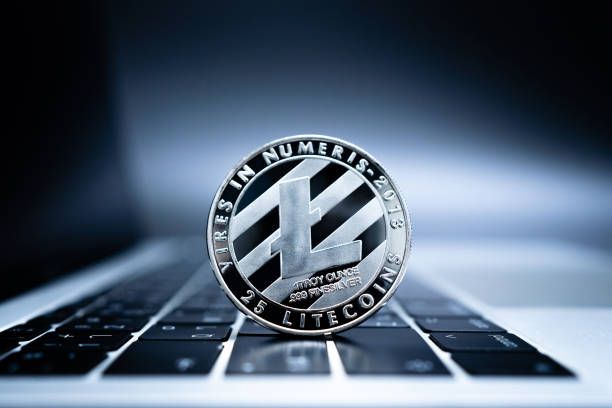
By 2011, Bitcoin mining was largely performed by GPUs. This raised concern in some users that mining now had a high barrier to entry, and that CPU resources were becoming obsolete and worthless for mining. Using code from Bitcoin, a new alternative currency was created called Tenebrix (TBX). Tenebrix replaced the SHA-256 rounds in Bitcoin's mining algorithm with the scrypt function, which had been specifically designed in 2009 to be expensive to accelerate with FPGA or ASIC chips. This would allow Tenebrix to have been "GPU-resistant", and utilize the available CPU resources from bitcoin miners. Tenebrix itself was a successor project to an earlier cryptocurrency which replaced Bitcoin's issuance schedule with a constant block reward (thus creating an unlimited money supply). However, the developers included a clause in the code that would allow them to claim 7.7 million TBX for themselves at no cost, which was criticized by users. To address this, Charlie Lee, a Google employee who would later become engineering director at Coinbase, created an alternative version of Tenebrix called Fairbrix (FBX). Litecoin inherits the scrypt mining algorithm from Fairbrix, but returns to the limited money supply of Bitcoin, with other changes.
Lee released Litecoin via an open-source client on GitHub on October 7, 2011. The Litecoin network went live on October 13, 2011.
It was a source code fork of the Bitcoin Core client, differing primarily by having a decreased block generation time (2.5 minutes), increased maximum number of coins, different hashing algorithm (scrypt, instead of SHA-256), and a slightly modified GUI.
During the month of November 2013, the aggregate value of Litecoin experienced massive growth which included a 100% leap within 24 hours.[better source needed]
In May 2017, Litecoin became the first of the top 5 (by market cap) cryptocurrencies to adopt Segregated Witness. Later in May of the same year, the first Lightning Network transaction was completed through Litecoin, transferring 0.00000001 LTC from Zürich to San Francisco in under one second.
In 2020, PayPal added the ability for users to purchase a derivative of Litecoin along with Bitcoin, Ethereum and Bitcoin Cash which could not be withdrawn or spent as part of its Crypto feature.
In September 2021, a fake press release was published on GlobeNewswire announcing a partnership between Litecoin and Walmart. This caused the price of Litecoin to increase by around 30%, before the press release was revealed as a hoax. In February 2022, Litecoin has reached a marketcap of $8.7 Billion.
In May 2022, MWEB (Mimblewimble Extension Blocks) upgrade has officially been activated on the Litecoin network as a soft-fork. This upgrade provides users with the option of sending confidential Litecoin transactions, in which the amount being sent is only known between the sender and received.
Differences from Bitcoin
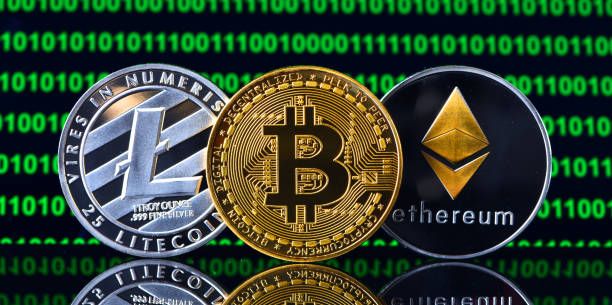
Litecoin is different in some ways from Bitcoin:
1.The Litecoin Network aims to process a block every 2.5 minutes, rather than Bitcoin's 10 minutes. This allows Litecoin to confirm transactions four times faster than Bitcoin.
2.Litecoin uses scrypt in its proof-of-work algorithm, a sequential memory-hard function requiring asymptotically more memory than an algorithm which is not memory-hard.[citation needed]
3.Litecoin has a maximum circulating supply of 84,000,000 LTC, which is four times larger than Bitcoin's maximum circulating supply of 21,000,000 BTC.[a]
| timestamping = Proof-of-work (partial hash inversion) | issuance_schedule = Decentralized (block reward)
Initially ₿50 per block, halved every 210,000 blocks.
Due to Litecoin's use of the scrypt algorithm, FPGA and ASIC devices made for mining Litecoin are more complicated to create and more expensive to produce than they are for Bitcoin, which uses SHA-256.
When it comes to Litecoin as a method of payment, in early days there was correlation to Bitcoin in terms of extended payment patterns. Although one might assume that payment patterns of Litecoin would converge to Bitcoin, it has been found that there is little correlation of the payment patterns of Litecoin vs Bitcoin today, and these patterns continue to diverge over time.
Digital currency
Digital currency (digital money, electronic money or electronic currency) is any currency, money, or money-like asset that is primarily managed, stored or exchanged on digital computer systems, especially over the internet. Types of digital currencies include cryptocurrency, virtual currency and central bank digital currency. Digital currency may be recorded on a distributed database on the internet, a centralized electronic computer database owned by a company or bank, within digital files or even on a stored-value card.
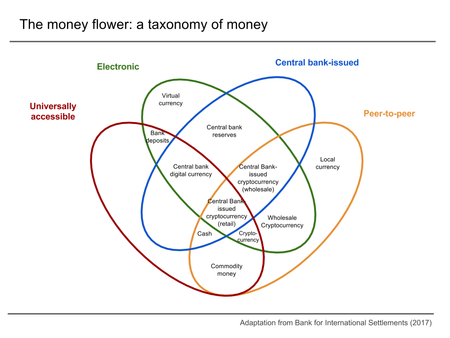
Taxonomy of money, based on "Central bank cryptocurrencies" by Morten Linnemann Bech and Rodney Garratt
Digital currencies exhibit properties similar to traditional currencies, but generally do not have a physical form, unlike currencies with printed banknotes or minted coins. This lack of physical form allows nearly instantaneous transactions over the internet and removes the cost associated with distributing notes and coins. Usually not issued by a governmental body, virtual currencies are not considered a legal tender and they enable ownership transfer across governmental borders.
This type of currency may be used to buy physical goods and services, but may also be restricted to certain communities such as for use inside an online game.
Digital money can either be centralized, where there is a central point of control over the money supply (for instance, a bank), or decentralized, where the control over the money supply is predetermined or agreed upon democratically.
History
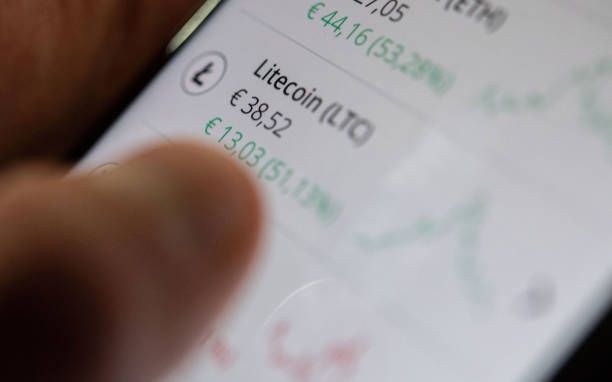
In 1983, a research paper by David Chaum introduced the idea of digital cash. In 1989, he founded DigiCash, an electronic cash company, in Amsterdam to commercialize the ideas in his research.[5] It filed for bankruptcy in 1998.
Sub-types of digital currency and comparisons
Digital currency as a specific type and as a meta-group name
Digital Currency is a term that refers to a specific type of electronic currency with specific properties. Digital Currency is also a term used to include the meta-group of sub-types of digital currency, the specific meaning can only be determined within the specific legal or contextual case. Legally and technically, there already are a myriad of legal definitions of digital currency and the many digital currency sub-types. Combining different possible properties, there exists an extensive number of implementations creating many and numerous sub-types of Digital Currency. Many governmental jurisdictions have implemented their own unique definition for digital currency, virtual currency, cryptocurrency, e-money, network money, e-cash, and other types of digital currency. Within any specific government jurisdiction, different agencies and regulators define different and often conflicting meanings for the different types of digital currency based on the specific properties of a specific currency type or sub-type.
Digital versus virtual currency
Main article: Virtual currency
A virtual currency has been defined in 2012 by the European Central Bank as "a type of unregulated, digital money, which is issued and usually controlled by its developers, and used and accepted among the members of a specific virtual community". The US Department of Treasury in 2013 defined it more tersely as "a medium of exchange that operates like a currency in some environments, but does not have all the attributes of real currency". The US Department of Treasury also stated that, "Virtual currency does not have legal-tender status in any jurisdiction."
According to the European Central Bank's 2015 "Virtual currency schemes – a further analysis" report, virtual currency is a digital representation of value, not issued by a central bank, credit institution or e-money institution, which, in some circumstances, can be used as an alternative to money. In the previous report of October 2012, the virtual currency was defined as a type of unregulated, digital money, which is issued and usually controlled by its developers, and used and accepted among the members of a specific virtual community.
According to the Bank for International Settlements' November 2015 "Digital currencies" report, it is an asset represented in digital form and having some monetary characteristics. Digital currency can be denominated to a sovereign currency and issued by the issuer responsible to redeem digital money for cash. In that case, digital currency represents electronic money (e-money). Digital currency denominated in its own units of value or with decentralized or automatic issuance will be considered as a virtual currency. As such, bitcoin is a digital currency but also a type of virtual currency. Bitcoin and its alternatives are based on cryptographic algorithms, so these kinds of virtual currencies are also called cryptocurrencies.
Digital versus cryptocurrency
Cryptocurrency is a sub-type of digital currency and a digital asset that relies on cryptography to chain together digital signatures of asset transfers, peer-to-peer networking and decentralization. In some cases a proof-of-work or proof-of-stake scheme is used to create and manage the currency. Cryptocurrencies can allow electronic money systems to be decentralized. When implemented with a blockchain, the digital ledger system or record keeping system uses cryptography to edit separate shards of database entries that are distributed across many separate servers. The first and most popular system is bitcoin, a peer-to-peer electronic monetary system based on cryptography.
Digital versus traditional currency
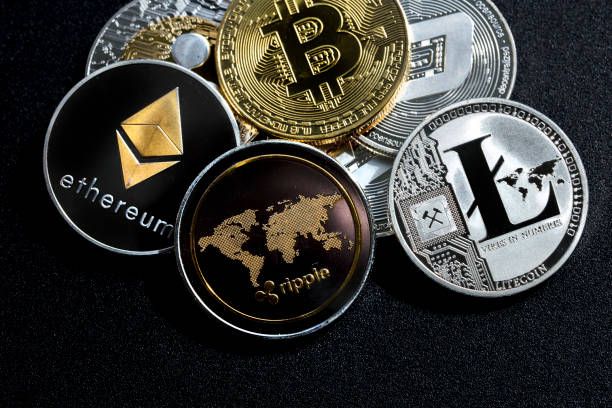
Most of the traditional money supply is bank money held on computers. They are considered digital currency in some cases. One could argue that our increasingly cashless society means that all currencies are becoming digital currencies, but they are not presented to us as such.
e-gold was the first widely used Internet money, introduced in 1996, and grew to several million users before the US Government shut it down in 2008. e-gold has been referenced to as "digital currency" by both US officials and academia. In 1997, Coca-Cola offered buying from vending machines using mobile payments. PayPal launched its USD-denominated service in 1998. In 2009, bitcoin was launched, which marked the start of decentralized blockchain-based digital currencies with no central server, and no tangible assets held in reserve. Also known as cryptocurrencies, blockchain-based digital currencies proved resistant to attempt by government to regulate them, because there was no central organization or person with the power to turn them off.
Origins of digital currencies date back to the 1990s Dot-com bubble. Another known digital currency service was Liberty Reserve, founded in 2006; it lets users convert dollars or euros to Liberty Reserve Dollars or Euros, and exchange them freely with one another at a 1% fee. Several digital currency operations were reputed to be used for Ponzi schemes and money laundering, and were prosecuted by the U.S. government for operating without MSB licenses. Q coins or QQ coins, were used as a type of commodity-based digital currency on Tencent QQ's messaging platform and emerged in early 2005. Q coins were so effective in China that they were said to have had a destabilizing effect on the Chinese Yuan currency due to speculation.Recent interest in cryptocurrencies has prompted renewed interest in digital currencies, with bitcoin, introduced in 2008, becoming the most widely used and accepted digital currency.